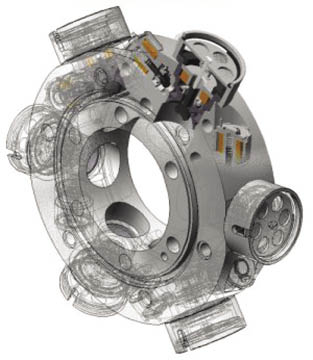SolteQ
Mogelijk hydraulisch windpark op zee
SolteQ is a company run from the watercampus in Leeuwarden, by Herre Rost van Tonningen. He is an innovative thinker and entrepeneur (you can find his Ning page here) when it comes to opening up the huge potential of renewables, especially for the carribean, where he spend a large part of his professional life. Recently he finished a solar car park, which not only solves the problem of hot carparks, but also optimizes land use and prepares for solar-electrical transportation.

Move the heavy stuff to the bottom, and save a lot of money on materials, maintenance, risk and complexity
Looking at local solutions to generating sweet water he found people where using windmills with simple mechnical pumps to use RO desalination. This had two interesting aspects, first the windmill where simpeler than when one uses an electrical generator, because of the reduced weight in the nacelle (gondola) also reducing cost of the tower and base, second the mechanical form of energy allowed many applications at lower cost because of reduced conversion losses and less parts in the system. Herre inproved this idea to use a hydraulic pump in the nacelle, transporting hydraulic pressure to the base of the wind turbine tower/pylon, and patented this idea as shown above.
The Solteq testing turbine, to be moved to Columbia. It uses a refurbished Lagerwey turbine tower and nacelle
Using mechanical energy instead of electricity also inspired the chinese to patent the use of a long axle to transmit power from the top of the tower to the bottom. This chinese patent can not be enforced except maybe for the very specific applications mentioned simply because its principle design is what has been in use in dutch windmills since the 1400s.
Another example of an hydraulic pump based wind turbine.
The above image follows the Solteq design with the exception that the pump is integrated in the turbine axle. This design may suffer from disadvantageous weight distribution. Companies like Artemis design ydraulic transmission systems, which actually are hydraulic pumps (called hydraulic drives), driving generators still located in the nacelle. As is said in the video, this changes the game for use of wind in many other fields of industry. An important innovation of Atermis is to have cilinders in the hydraulic pump switched on and of depending on the power available, so that the rotational speed can remain constant (ok, that’s what a gear box does).

Rotary hydraulic pump reminiscent of rotary engines for planes
The proof of the pudding is in the eating, and the world desperatly needs good ideas to be actually build because most people only respond to the reality they personally experience (which doesn’t work for dealing with the dangers of climate change). Below we see the inside of the base cabin, which can be a shipping container. Inside it are two systems, one RO system for making fresh water, the other is a hydroelectric generator that can use the excess pressure from the turbine. With this device one will have sweet water and electricity in any place with wind and salt water.
The cost of the hydraulic and RO part is about 50/50, and not particularly cheap. Water can be very expensive in some regions, especially islands. The use of fuels to power RO water desalination creates high and sometimes prohibitive running costs. Using wind to at least eliminate those cost is an obvious step.
Solteq has sold its first turbine to Columbia, where it will be erected on a nature reserve island (see picture below). The island draws tourists but there is no infrastructure to provide them with fresh water or other services. The turbine will do just that. Because of the rules for building in a nature protected area the turbine will be lower than its current 30 meter, and the mast will be hydraulically pumped up, instead of consist of stacked tubes (there will be no crane at the location)
Islands are the ideal locations to go full renewables, because they usually undergo less economic pressure, making it easier to escape the domination of the fossil/banking system that tries to maintain our dependence on fossil fuels as not to lose fossil fuel cash flows and credit dependency. This is easier to achieve this in densly populated land regions than on remote islands. We may see tropical islands go 100% (and subsequently 200% etc.) sustainable sooner than other parts of our world.
Dutch Rainmaker

Another interesting wind turbine we say on our trip to visit Solteq is the Dutch Rainmaker. It also has a pump system in its nacelle, but it does something different from the solteq turbine, because instead of desalinating it condenses water out of the air. So even though the Solteq turbine has a higher capacity and simpler design, it can not make water in the desert where the Dutch Rainmaker can. Still it is a question if water logistics combined with desalination does not reduce the need for direct extraction of water from the air.
It seems wind is slowly escaping the clutches of (fossil fuel dependent) bank sector supression of renewable energy, which started with denying credit to many wind projects, driving up cost by demanding super safety and clumsy heavy designs. One has to compare this to financing of new oil or nuclear energy technology for which many security, safety issues are being skirted on a regular basis. Not we see designs that are simply to easy to build, for which there are to many ‘free’ parts manufacturers and that break conventions held sacred (like the idea that going primary wind/electric is always the cheapest option) become reality. Wind is going to be even more competitive as the cheapest form of renewable energy than it already was.

SolteQ Energy B.V.
Water Campus
Agora 4,
8934CJ, Leeuwarden ,
The Netherlands
phone: +31 653234443
A smaller version of the Solteq design is produced by the ‘Drinking with the wind’. More info here.






